|
Secrets of the Third Reich
Part III
Another scientist who brought new knowledge to America was Viktor Schauberger. Although there is no evidence that Schauberger had Nazi
sympathies, he was viewed by the Americans as a collaborator and put
‘into protective custody’ for six months at the end of the war.
Dr Walter Miethe, and Rudolph Schriever also entered America under
Operation Paperclip, however it is believed that their colleague
Habermohl fell into Russian hands.
Whilst in the US, Miethe continued his ‘flying disk’ work working
primarily for the US Air Force, however he was sub-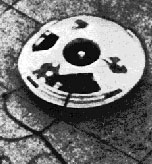 contracted to A.
V. Roe and Company. contracted to A.
V. Roe and Company.
In 1959 Jack Judges, a freelance cameraman was flying over this
company’s plant in Canada when he saw and photographed this picture
(left) of a disk shaped craft sitting on the ground.
After the photograph was published in the papers, speculation grew
that the disk was a secret weapon, and one that may have accounted
for many of the UFO sightings during previous years.
In response to the speculation, the US Air Force released the
following official photograph of the craft. It was called the ‘Avro’
and had first been launched in 1955.
A CIA memo of that year confirmed that the craft was based work
undertaken by German scientists, notably Miethe, during WWII. The
design was later abandoned in the late 1960s with the Air Force
maintaining it was still at an experimental stage when abandoned.
The 1990s were to reveal the craft was part of the secret ‘Project
Silver Bug’, a project to develop a craft that had VTOL (vertical
take-off and landing) capabilities that would dispense with the need
for runways – and reduce the
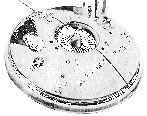 risks of such runways been targets of
attack thus immobilizing any aircraft that may rely on it. risks of such runways been targets of
attack thus immobilizing any aircraft that may rely on it.
Other German scientists similarly brought their expertise – and
designs – into the US after the war. ‘America’s Aircraft Year Book’
notes how many of them worked at Ft. Bliss (von Braun et al above)
and Wright Field: the first and second homes of the Roswell
wreckage. Among those in the German group at Wright Field were
Rudolph Hermann, Alexander Lippisch, Heinz Schmitt,
Helmut Heinrich,
Fritz Doblhoff and Ernst Zundel.
Hermann was attached to the Peenemunde Research Station for
Aerodynamics where Germany’s V-2 rockets were hatched and launched
against England. A specialist in supersonics, he was in charge of
the supersonic wind tunnel at Kochel in the Bavarian Alps. He was
also a member of the group entrusted with Hitler’s futuristic plans
to establish a space-station rocket-refueling bases revolving as a
satellite about the Earth at a distance of 4,000 miles – a scheme
which he and certain high ranking AAF officers in 1947 still
believed possible."
One of these scientists Dr. Alexander Lippisch had designed another
German craft that could be mistaken at the time for a
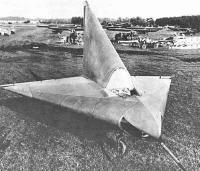 flying disc,
certainly at least when viewed from the side. flying disc,
certainly at least when viewed from the side.
Lippisch had developed a number of projects leading up to the war,
having been inspired by witnessing a flight by Orville Wright in
September 1909 when a boy of 14. By November 1944, Lippisch, along
with his students, had constructed the DM-1 (left), a delta with 60°
swept leading edges. This craft was later to be flown at a speed of
497mph under the power of a rocket motor, and was shipped back to
the US at the end of the war along with its creator. The DM-1 was to
inspire the design of many US delta-wing aircraft such as the F-102
and F-104.
Lippisch joined Collins Radio Company as an expert on special
aeronautical problems and in 1966 founded the ‘Lippisch
Corporation’. He went on to develop the X-113A Aerofoil Boat before
dying in 1976 at the age of 81.
Another craft that looked suspiciously like a ‘flying disk’ was the
AS-6 (click right image). This craft was built by
Arthur Sack following
 encouragement
from Ernst Udet, Germany’s Air Minister in 1939. encouragement
from Ernst Udet, Germany’s Air Minister in 1939.
Constructed at the Mitteldeutsche Motorwerke Company, and completed
at the Flugplatz-Werkstatt at the Brandis Air Base in early 1944,
the plane was not a success, and not further developed.
A similar craft to the AS-6, the V-173, was built by ‘Chance-Vought’,
and known as the ‘flying pancake’. The V-173 has the honour of being
the one occasion that the US authorities actually ‘admitted’ that
technologies developed in Germany during the war years could account
for the wave of UFOs seen over America in the 1940s.
The Navy released this picture of a V-173 in 1947 during the wave of
UFO excitement generated by Kenneth Arnold’s sighting and the
headline of the saucer crash at
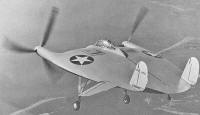 Roswell. Roswell.
The Navy stated that the V-173 (click
image left) was the only craft in operation at
that time that could in any way come close to the flying disks being
sighted everywhere.
Certainly the V-173, or another development at Chance-Vought was
mistaken for a UFO by a local resident Thomas C. Smith whilst
working for the company a year before the famous Roswell incident.
In 1997 Smith disclosed his story which appeared in the Lancaster
New Era newspaper in Lancaster, Pennsylvania on 12th July, 1997. In
the article Smith stated he had seen a flying saucer, but not a
visitor from another planet but one that "was a human-engineered,
experimental aircraft nestled in a Connecticut hangar.
"‘My God, what is that?’ the 20-year-old Smith wondered. ‘It was
standing there on these stilts.’ It reminded Smith of something out
of Orson Welles' 1938 radio broadcast ‘The War of the Worlds,’ about
a Martian invasion of Earth. Armed with U.S. government security
clearance, Smith watched, he says, as the 40-foot-wide elliptical
craft hovered 10 feet off the ground and flew away, driven by twin
propellers. A pilot lying in a cramped cockpit guided the craft.
Smith, now a retired 72-year-old executive, recalled the experience
during the UFO frenzy created by the 50th anniversary of the Roswell
episode this month. Does he have proof that a craft like the one he
saw crashed in Roswell during a test flight? No, but he says he
believes that theory is more probable than visitors from outer
space.
At the time, Smith was a mechanical-engineering graduate just out of
Penn State University. He was working for Chance-Vought Aircraft in
Stratford, Conn., which was building planes for the U.S. Navy. Smith
was testing the high-altitude bonding of a composite material: wood
sandwiched between two layers of metal.
He says he was curious about what would be built with the material,
and since he had security clearance, a supervisor led him into a
guarded hangar. He was shown a new jet the company was developing,
but his attention was attracted to the other craft in the hangar, a
flying saucer made of the material he had been testing.
‘It was very streamlined,’
Smith recalls. The khaki-coloured saucer
was a few inches thick at the edges to about two feet thick at the
pilot's cockpit, which had a bubble window allowing the pilot to
look forward and down at the ground. ‘I saw him get in, and he lay
down flat,’ Smith says. The craft had two propellers and rudders in
the back. Smith went back at night to watch test flights. The
saucer, he says, would float straight up, then fly off.
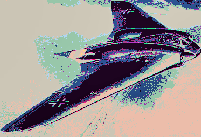 ‘They'd get it off the ground and it would disappear’ into the
darkness, he says. He says there were reports in the area of
unidentified flying objects. About the time he left Chance-Vought in
1947, it moved operations to Texas, where it would have better
conditions for test flights, Smith says."
(24) Thus, Chance-Vought
moved to a state next to New Mexico the year of the Roswell crash. ‘They'd get it off the ground and it would disappear’ into the
darkness, he says. He says there were reports in the area of
unidentified flying objects. About the time he left Chance-Vought in
1947, it moved operations to Texas, where it would have better
conditions for test flights, Smith says."
(24) Thus, Chance-Vought
moved to a state next to New Mexico the year of the Roswell crash.
Other aircraft, at the time, seemed equally unconventional. In the
1930s and 1940s in Germany, the Horten brothers, Walter and
Reimar,
built a range of planes that they called the ‘Ho’ series. The first
of this series, the
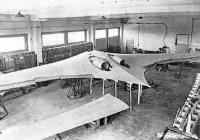 Ho I, was a simple flying-wing sail plane. Ho I, was a simple flying-wing sail plane.
By the end of that decade the brothers had developed the Ho III, a
metal framed glider that was fitted with a folding blade propeller
for flight. Then in 1944 they finished the prototype HO IX
(click left), their
first combat intended design, powered by the Junkers Jumo 004B
turbojets, the craft had a metal frame and plywood exterior
(Appendix I) It made its maiden flight on 2nd February 1945 and
satisfied with its performance, the Air Ministry ordered forty of
the craft to be built by the Goetha Waggonfabrik under
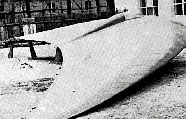 the
designation Ho-229. the
designation Ho-229.
When the US Third US Army Corps reached
the Goetha plant on 14th
April 1945 they took over the factory, and shipped back to the US
the near completed HO IX V3.
Another similar looking craft was this ‘airplane’ photographed in
Germany at the end of the war.
In fact, many of these German designs seemingly account for many of
the reports of Unidentified Flying
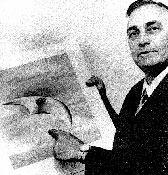 Objects seen over the US after
the war. Objects seen over the US after
the war.
Kenneth Arnold himself described what he saw as a flying disc, yet
when Arnold actually drew a picture of what he had seen, it looked
little like the popularly conceived silver-round disc that readily
springs to mind.
In fact, the diagram Kenneth Arnold actually drew of what he had
seen that fateful day in 1947 looks remarkably like the German HO IX
or other craft
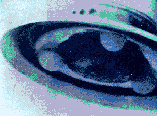 developed during the war. developed during the war.
George Adamski’s UFOs also have a similar Nazi connection. This
light enhanced frame from a 8mm cine film taken by George Adamski in
the presence of Madeleine Rodeffer (Picture credit: Madeleine Rodeffer) and other witnesses at Silver Spring, Maryland in February
1965, looks remarkably like the drawings for the Nazi Haunebu II
during the second world war.
Notice the bubble effects under the diagram of the Nazi craft and
those captured in the alleged Adamski UFO.
 Indeed, it obviously is
the Haunebu craft. Indeed, it obviously is
the Haunebu craft.
Again, this object photographed in February 1954 by
Stephen Darbishire and his cousin Adrian Myers in the Lake District of
England looks suspiciously like the German craft.
Its contours and design are too much like
the Haunebu craft to be a
coincidence, and
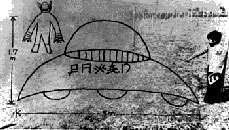 on the bottom left hand side can be seen one of the
‘bubbles’. on the bottom left hand side can be seen one of the
‘bubbles’.
This following picture was drawn following an alleged UFO touchdown
near Kofu City, Yamanshi Prefecture in Japan on 23rd February 1975 –
thirty years after cessation of hostilities in Europe. According to
the artist, an occupant came out of the craft and touched a child on
the shoulder, temporarily paralyzing him. (Well, wouldn’t you be
startled if an alien touched you?)
The idea of such flying disks should come as no surprise for after
the war there were a number of such designs
 in existence.
This craft was developed by the Lockheed Skunk Works in Palmdale,
California. in existence.
This craft was developed by the Lockheed Skunk Works in Palmdale,
California.
An unmanned aerial reconnaissance vehicle, it had a saucer shaped
body with long wings and could easily be mistaken for a flying disk
when seen at certain angles.
This craft (click below
right image), is the prototype of a giant ‘flying saucer’
designed to revolutionize air transport. Designed by British firm,
Airship Industries, the Skyship was planned to cruise at about 100
miles an hour at an altitude of
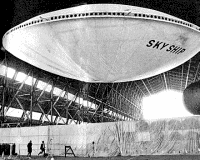 5000 feet. 5000 feet.
It seems likely, therefore, that many of the UFO sighting reports
made after the war can be accounted for by misidentified or
unrecognized German/US designs that were being developed in a
secrecy necessitated by firstly the Cold War and secondly by the
fact that most of the technologies were the result of works
undertaken by former Nazi scientists secretly and often illegally
brought into the US.
Yet this cannot account for all of the sightings, for it is
inconceivable that the CIA, NSA, FBI etc. would have been in such a
blind panic as described in previous chapters had the sightings
simply been known terrestrial if unconventional aircraft. (Each
agency may not always have been aware of all developments at all
times, but the official investigation into the UFO phenomena in the
US went on officially for over twenty years, it would not be
unrealistic to have expected a terrestrial explanation to have been
circulated within that time frame.)
So if unconventional but terrestrial craft cannot account for many
of the sightings – and the official interest – then what can. There
have certainly been rumors circulating for many years that the
German designs were actually man-made attempts to reproduce crashed
real ‘flying saucers’ - attempts that failed because the engineers
and scientists involved were unable to recreate the steering and
propulsion systems of the alleged crashed craft.
As bizarre as this sounds, this claim certainly better explains the
number of sightings over hundreds if not thousands of years and the
inability of the major governmental agencies to account for much of
the activity in the skies after the war. And it is a claim that is
backed by some major players on the world stage.
One of the most impressive of those backing this claim is
Colonel
Philip J. Corso (Ret.) (left with
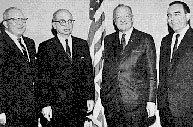 Edwards O’Connor, Corso, Lt.
Gen. Arthur Trudeau and Victor Fediay). Edwards O’Connor, Corso, Lt.
Gen. Arthur Trudeau and Victor Fediay).
Corso published a book entitled ‘The Day After Roswell: A Former
Official Reveals the US Government’s Shocking UFO Cover-up’ in which
he makes a number of revelations.
Corso’s background itself is formidable. He was Chief of the US
Army’s Foreign Technology Division, and was a member of President
Eisenhower’s National Security Council. He later went on to work for
Senator Strom Thurmond after retiring from the army in 1963. Corso
was interviewed by Michael Lindemann of CNI News on 5th July 1997
and asked:
ML: There have been rumours and speculations that Roswell, and what
came from Roswell – the way we exploited Roswell technology – might
not have been the very first time such a thing happened. There have
been indications or speculations that the Nazis had done such a
thing, that some of their extraordinary technological developments
may have come from a similar source. What do you think of that?
PC: Yes. True. I had German scientists on my team. I discussed this
with them. I discussed this with Oberth, von Braun. I was part of
‘Project Paperclip’ with General Trudeau… There were crashes
elsewhere, and they [the Germans] gathered material too. The Germans
were working on it. They didn’t solve the propulsion system. They
did a lot of experiments on flying saucers. They had one that went
up to 12,000 feet. But where all, we and they, missed out was on the
guidance system. In R&D we began to realize that this being [a
captured alien] was part of the guidance system, part of the
apparatus himself, or itself, as it had no sexual organs."
In his book Corso also describes the UFO that crashed at Roswell and
noted General Twinning’s observations regarding the design:
"The
crescent-shaped craft looked so uncomfortably like the German Horten
wings our flyers had seen at the end of the war that he had to
suspect the Germans had bumped into something we didn’t know about.
And his conversations with Wernher von Braun and Willy Ley at
Alamogordo in the days after the crash confirmed this. They didn’t
want to be thought of as verruckt but intimated that there was a
deeper story about what the Germans had engineered."
(25)
Certainly this ‘deeper story’ was confirmed by the father of the
modern rocket, Hermann Oberth. He independently confirmed that
during the war years there was a Nazi-Extra-terrestrial connection
when he stated,
"we cannot take credit for our record advancement in
certain scientific fields alone. We have been helped."
When asked by
whom, he replied, "the peoples of other worlds."
(26)
Wernher von Braun was equally frank about the issue and did not
doubt that extraterrestrials were visiting the Earth nor that many
of the advancements he was involved in were a result of back
engineering alien technology. Indeed, he talked openly about the
issue following an incident on 3rd June 1959 when the ‘Discoverer
III’ failed to achieve orbit, having been deflected whilst travelling. Von Braun commented,
"We find ourselves faced by powers,
which are far stronger than we had hitherto assumed, and whose base
is at present unknown to us. More I cannot say at present. We are
now engaged in entering into closer contact with those powers, and
in six or nine months it may be possible to speak with some
precision on the matter." (27)
If these reports from Oberth and
Von Braun are to be believed, then
clearly the Germans held a knowledge not previously available to the
Western allies.
And it appears that the scientists entering the US
after the war under the auspices of
Operation Paperclip shared this
knowledge with the US military who within weeks set in place one of
the fastest but little known invasions of the Twentieth Century.
References:
(24) Lancaster New Era newspaper, 12th July 1997.
(25) Corso, Philip, ‘The Day After Roswell’ p. 79 Pocket Books, New
York 1997
(26) Collyns, Robin, ‘Did Spacemen Colonize the Earth?’ p. 236,
Pelham Books, London 1974.
(27) ‘News Europa’ Jan 1959
|
 contracted to A.
V. Roe and Company.
contracted to A.
V. Roe and Company. risks of such runways been targets of
attack thus immobilizing any aircraft that may rely on it.
risks of such runways been targets of
attack thus immobilizing any aircraft that may rely on it.


 ‘They'd get it off the ground and it would disappear’ into the
darkness, he says. He says there were reports in the area of
unidentified flying objects. About the time he left Chance-Vought in
1947, it moved operations to Texas, where it would have better
conditions for test flights, Smith says."
(24) Thus, Chance-Vought
moved to a state next to New Mexico the year of the Roswell crash.
‘They'd get it off the ground and it would disappear’ into the
darkness, he says. He says there were reports in the area of
unidentified flying objects. About the time he left Chance-Vought in
1947, it moved operations to Texas, where it would have better
conditions for test flights, Smith says."
(24) Thus, Chance-Vought
moved to a state next to New Mexico the year of the Roswell crash.

 the
designation Ho-229.
the
designation Ho-229. Objects seen over the US after
the war.
Objects seen over the US after
the war.  developed during the war.
developed during the war.
 Indeed, it obviously is
the Haunebu craft.
Indeed, it obviously is
the Haunebu craft.  on the bottom left hand side can be seen one of the
‘bubbles’.
on the bottom left hand side can be seen one of the
‘bubbles’. in existence.
This craft was developed by the Lockheed Skunk Works in Palmdale,
California.
in existence.
This craft was developed by the Lockheed Skunk Works in Palmdale,
California. 
 Edwards O’Connor, Corso, Lt.
Gen. Arthur Trudeau and Victor Fediay).
Edwards O’Connor, Corso, Lt.
Gen. Arthur Trudeau and Victor Fediay).